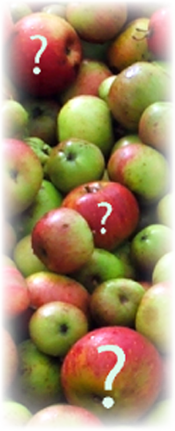Identification
With many hundreds of different varieties of apple and pear, identification is an exceptionally tricky activity to undertake. Many a discussion has started around the features of an ‘unknown’ apple, which ends up remaining an ‘unknown’ apple. Well, how many different shades of green, red and yellow can you get – not to mention its shape and texture.
One rule of thumb with any apple variety intended for cider (or eating/cooking, for that matter) is to taste it. It is the one way of knowing if you are holding a sweet, sharp or bitter apple; whether you can tell if there are tannins; whether it tastes strong or weak… or if it’s just simply nasty!
We welcome the challenge of trying to identify an apple on the Cider Workshop, so do ask. However, if you have found it on a roadside the chances are it’s the offspring of a core thrown from a window of a car and will be unlikely to qualify as anything but a ‘roadside apple’. However, if it tastes good, then there is no reason to hold it back from a cider.
For those who have a little funds, and are serious about finding out identification, the best odds are by applying to the Brogdale Horticultural Trust. They will require a fee (and a sample of the apple) in order to attempt idenfication, and have over 90 named cider apple, 1800 general apple and 450 pear (including 20 perry pear) varieties they could match it to. Follow the link below to their website:
Andrew Lea's Wittenham Hill Cider Portal is also worth a visit, if you fancy trying to identify your own.


